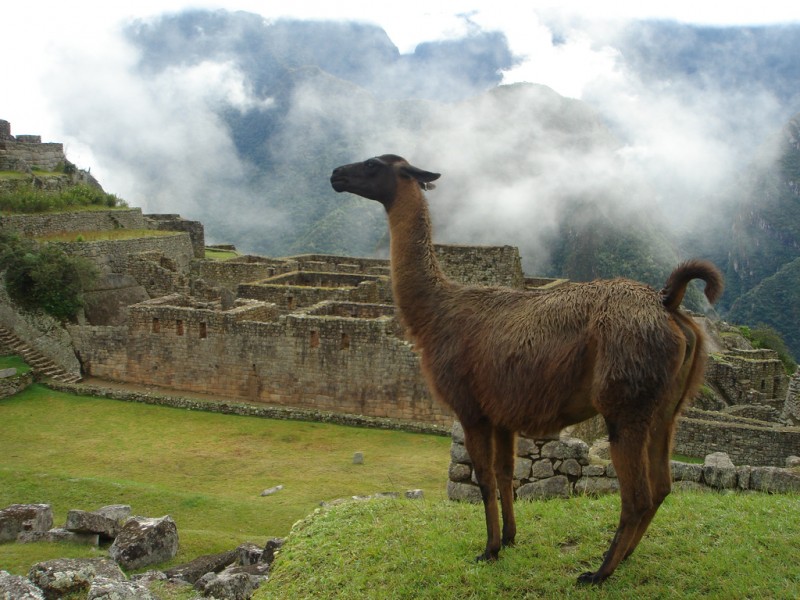
Image on Flickr by user Marcelo Dondo (CC BY-ND 2.0).
Every year, Peru carries out the chaccu, when vicuñas (wild relatives of the llama) are sheared for their wool. It happens in the final week of June at Pampa Galeras-Bárbara d'Achille Natural Reserve, in Ayacucho. This traditional hunt for the vicuna dates back to pre-Hispanic times.
With the cry of “¡Chacutay jayaycusa!” (Let's start chaccu!), followed by the answer “Chaccu!” this annual event starts, as described by website turismoi.pe:
Chaccu es una palabra quechua que es utilizada para una práctica específica, la cual consiste en la persecución, captura y esquila de las vicuñas. Para este proceso se rodea al grupo de animales dentro de una amplia extensión que poco a poco se va cerrando hasta poder obtener a cada uno de estos para ser esquilados.
Chaccu is a Quechua word that is used for a specific practice: chasing, capturing, and shearing the vicuñas. For the process, the group of animals is surrounded within a huge area that little by little gets enclosed until every animal is captured and be sheared.
The vicuña is one of four species of Andean camelids:
La vicuña es el animal que tiene la fibra natural más fina del mundo –un kilogramo de fibra de vicuña tiene un precio superior a los cuatrocientos dólares. Vive en grupos encabezados por un macho adulto y se reproduce una vez al año. La captura de la vicuña demanda gran esfuerzo físico, no solo por su velocidad, sino principalmente porque vive en las partes altas de los Andes, en la puna o páramo, una zona de alta montaña caracterizada por su clima hostil.
The vicuña is the animal with the finest natural fiber in the world—a kilogram of vicuña fiber costs more than four hundred dollars. They live in groups led by an adult male and reproduce once a year. Capturing the vicuña requires huge physical effort, not only due to their speed, but mainly because they live in the highlands of the Andes, in the puna or paramo, a high mountain area known for its hostile weather.
The purpose is to get the vicuña fiber without hurting the animal or damaging the fiber itself. Once the shearing is carried out, the product goes through another process:
Un grupo de personas, principalmente mujeres, se encargan de recibir el vellón y lo doblan con especial técnica como si fuera una camisa que se empaca para un viaje. Doblan las mangas y el cuerpo del vellón hasta obtener un paquete de 15 por 15 cm que se introduce en una bolsa de polietileno, etiquetando el origen de la fibra y si es de macho o hembra. Luego de terminar la esquila, se cuenta el número de animales esquilados y se libera a todas las vicuñas hasta el próximo año.
A group, formed mainly by women, is in charge of receiving the fleece and folding it with a special technique, as if it were a shirt that gets packed for traveling. They fold the sleeves and the body of the fleece until they have a 15×15 centimeter package, which is placed into a polyethylene bag with a label indicating the origin of the fiber and whether it comes from a male or a female. Once the shearing is done, the animals are counted up and the vicuñas are freed until next year.
In 2012, the Peruvian Ministry of Agriculture reinstituted an evaluation program to establish how many vicuñas there are in the country. According to the government's findings, the population of these South American camelidos nationwide is 209, representing a 76-percent increase since 2000. Ayacucho is the area with the most vicuñas, with an estimated 62 animals, representing 29 percent of the total population.
The blog Alpacas y Alpaqueros shared the results of the 2012 National Vicuña Survey:
Los resultados arrojan que la población total de vicuñas en el Perú es de 208.889 animales de los cuales el 70% está en condición silvestre y el 30% en condición de semicautiverio.
The results show that the total population of vicuñas in Peru amounts to 208,889 animals, from which 70 percent are wildlife and 30 percent are feral.
Also, Twitter users shared some pictures of chaccu:
Chaccu milenaria tradición de trasquilar vicuñas … Y pensar que disfrutamos de ellas por la labor de Dr. A. Brack http://t.co/BTt5CfJhtj
— Cesar A. Ipenza (@cipenza) junio 24, 2015
Chaccu, millenary tradition of vicuña shearing… And to think we enjoy them thanks to the work by Dr. A. Brack [The recently late Dr. Antonio Brack was an agronomist engineer, ecologist, and researcher who was the first Peruvian Minister of the Environment].
Todo listo para el #ChaccuNacional2015 en #PampaGaleras http://t.co/soYsdcTJcy pic.twitter.com/Auj1bq6QUF — INFOREGION (@inforegion) junio 23, 2015
Everything is ready for 2015 National Chaccu at Pampa Galeras National Park.
PERÚ: El chaccu: una tradición ancestral que se escenifica en Pampa Galeras http://t.co/0InzoD5aKN @entornoi pic.twitter.com/uSU9drYXgC
— EntornoInteligente (@ENTORNOi) junio 22, 2015
PERU: Chaccu: ancestral tradition that is carried out at Pampa Galeras National Park.
On Facebook, Aventura sin Límites posted pictures of the latest chaccu.






